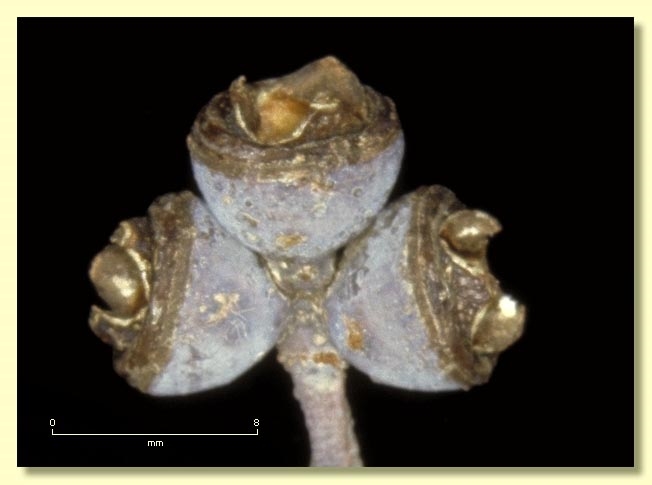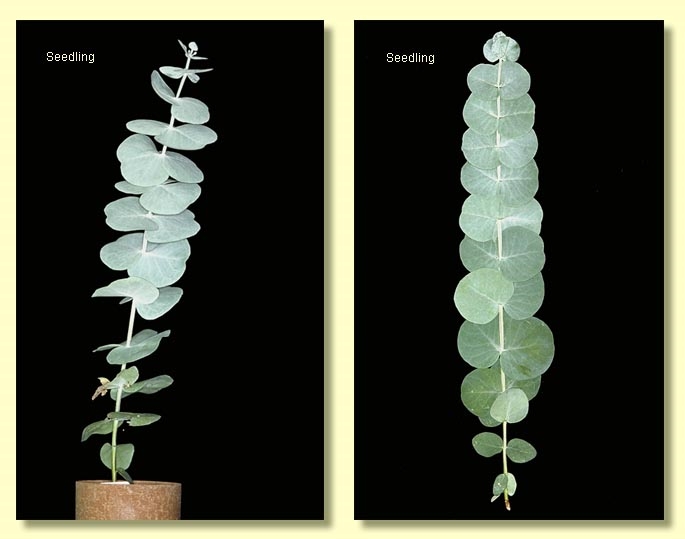Euclid - Online edition
Eucalyptus canobolensis
Eucalyptus | Symphyomyrtus | Maidenaria | Euryotae | Viminales | Circulares
E. rubida subsp. canobolensis L.A.S.Johnson & K.D.Hill, Telopea 4: 239 (1991). T: NSW, Central Tableland, Mt Canobolas, Orange, Jan. 1908, J.L.Boorman; holo: NSW.
Bark smooth throughout or with some persistent rough, greyish bark at the base of trunk; smooth bark often powdery, white, cream, pale grey, yellow-orange or pink, sometimes horizontal black scars present, at times with ribbons of decorticated bark in the upper branches; branchlets glaucous.
Juvenile growth (coppice or field seedlings to 50 cm): stem square in cross-section, glaucous; juvenile leaves opposite and sessile for many nodes (until ca 1.5–2 m tall), orbicular to wider than long, (2.3)3–11 cm long, (2.5)3.5–11 cm wide, bases rounded, truncate or amplexicaul, margin entire or crenulate, apex emarginate or rounded and acuminate, glaucous. Crown silvery grey to green.
Adult leaves alternate, petiole 1.2–3.5 cm long; blade lanceolate, 6.5–19 cm long, 1.1–3.7 cm wide, base tapering to petiole, concolorous, dull, grey or glaucous, weathering slightly glossy, light green inside the crown; side-veins greater than 45° to midrib, densely to very densely reticulate, intramarginal vein parallel to and just within margin, oil glands usually obscure or with a few island or intersectional.
Inflorescence axillary unbranched, peduncles 0.3–0.9 cm long, buds 3 per umbel, sessile or on pedicels to 0.2 cm long. Mature buds ovoid to fusiform, ca 0.6 cm long, ca 0.4 cm wide, glaucous, scar present, operculum conical, stamens irregularly flexed or inflexed, anthers cuboid to cuneate, versatile, dorsifixed, dehiscing by longitudinal slits (non-confluent), style long, stigma blunt, locules 3 or 4, the placentae each with 4 vertical ovule rows. Flowers white.
Fruit sessile or on pedicels only 0.1 cm long, cup-shaped, obconical or campanulate, 0.5–0.6 cm long, 0.5–0.8 cm wide, glaucous or non-glaucous, disc raised-convex or oblique, valves 3 or 4, usually exserted.
Seeds black or brown, 1.5–2.5 mm long, ovoid or flattened-ovoid, often pointed at one end, usually lacunose, dorsal surface more or less smooth, hilum ventral.
Cultivated seedlings (measured at ca node 10): cotyledons bilobed; stems square in cross-section, glaucous; leaves opposite and sessile for many nodes, cordate to orbicular, 3.5–4.5 cm long, 4–6 cm wide, amplexicaul or base truncate to rounded, margin entire or subcrenulate, apex rounded to emarginate or sometimes pointed, dull, glaucous.
Flowering has been recorded in February.
A woodland tree endemic to New South Wales, restricted Mt Canobolas near Orange, west of the Blue Mountains. It has at times a conspicuous silvery grey crown but may also be green, and large, glaucous, orbicular juvenile leaves that persist until sapling stage. Intermediate leaves large, prominently silver-grey.
Originally described as a subspecies of E. rubida but was recently elevated to species rank because of the coarseness of juvenile leaf growth on consistently square stems when compared with that species. Otherwise it looks like Eucalyptus rubida.
Eucalyptus canobolensis belongs in Eucalyptus subgenus Symphyomyrtus section Maidenaria, a large group of species more or less restricted to south-eastern Australia, characterised by bilobed cotyledons, simple axillary inflorescences, buds with two opercula the outer of which falls early in bud development, stamens with versatile anthers and flattened seeds with a ventral hilum. Within this section, E. canobolensis belongs in series Viminales subseries Circulares, having buds in threes, fruit with an ascending disc and exserted valves, and glaucous, sessile, orbicular juvenile leaves opposite for many pairs. Note however that whilst Eucalyptus canobolensis was described before the publication of Brooker (2000) it was not included in his classification of the eucalypts.
Eucalyptus canobolensis (as E. rubida subsp. canobolensis) is listed as "Vulnerable" under the Australian Government Environment Protection and Biodiversity Conservation Act 1999 (EPBC Act). Further information may be found at this web address:
http://www.environment.gov.au/cgi-bin/sprat/public/sprat.pl















